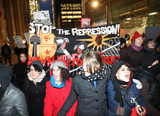
2011-11-23
Peter Small and Peter Edwards
“Smashy smashy,” Molotov cocktails, and firing paint-balls at riot police visors were among the actions anti-G20 activists discussed in meetings aimed at causing “widespread mayhem, chaos and destruction” at the Toronto summit last year, according to Crown allegations at the 17 defendants’ bail hearings.
Embedded in the meetings in Kingston, Peterborough, Guelph, Kitchener-Waterloo and Toronto were two undercover police officers — Bindo Showan and Brenda Carey — whose allegations formed the basis of the prosecution’s case against the accused.
The identity of the OPP officers had been protected by a publication ban, but that ban has now been lifted.
Prosecutors said the protesters had a “Tourist Attraction List” for what they termed “property modification,” i.e. vandalism.

The list included the Immigration and Refugee Board, Toronto City Hall, Metro Hall, Goldman Sachs, CIBC’s main office, the TD Trust Tower, RBC brokerage, Canada Trust, the U.S., Russian and Israeli consulates, Yorkville and Queen’s Park.
They planned to use hotel worker contacts to disrupt hotels where G20 delegates were staying, prosecutors said.
They discussed throwing golf balls, opening fire hydrants, attacking security cameras, tearing down the G20 security fence, assaulting police and starting fires to “take back the streets.”
Among the equipment seized by police were spray paint cans, bolt cutters, lighter fluid, handcuffs, slingshots, plastic ties, crowbars and ball bearings, the Crown alleged.
While undercover, Carey actually lived with some of the accused in Guelph for almost six months, often cooking for them and driving them to anarchist meetings.
When not performing motherly chores for the activists, she reported back to the RCMP-led Joint Intelligence Group (JIG), which focuses on extremism and terrorism.
Its mandate had been to keep watch over the Vancouver Olympics and Torch Relay, and the G8/G20 summits.
One anarchist blog described the soft-spoken infiltrator as a “sympathetic neighbour, and a pleasant, charming person to be around.”
Twice the age of some of the accused people, the undercover operator told them she was fleeing an abusive relationship.
Carey worked her way into their circles after attending an info-session at the University of Guelph for people interested in getting involved with the Guelph Union for Tenants and Supporters (GUTS).
Soon, she was cooking at anarchist-punk houses and attending anti-authoritarian/anarchist public events, according to the blog.
By the spring of 2010, she was living in Guelph in a house with activists.
For the police task force, this was a major coup, since it sidestepped the paperwork and legal challenge involved in getting a judge’s authorization to plant listening devices in activists’ residences.
Most of the time, she apparently operated without wearing listening devices, the blog said.
“She didn’t bring up ideas for projects but rather helped the unwitting anarchists with tasks,” a posting on an anarchists’ blog said, adding that she “didn’t act sketchy for quite some time; in fact she seemed fairly innocent and genuinely interested.”
She listened up-close despite the fact they were extremely security-conscious.
Activists refused to discuss actions on the Internet, turned off cellphones and removed their batteries during meetings. They used a vouching system to screen participants.
At a series of meetings, activists talked of using the peaceful Canadian Labour Congress march on June 26 as a cover for violent protesters to “black up” — don black clothing and disguises — then commit violent acts, court heard. This in fact happened.
They plotted events such as Saturday Night Fever, a disruptive street party with DJs atop trucks and loud boom boxes (whose batteries could be thrown when depleted); Get off the Fence, and a Jail Solidarity Party, according to the Crown’s allegations, which were not proved in court.
The Spokes Council of the Southern Ontario Anarchist Resistance functioned as the executive for a host of affiliated groups that were planning to disrupt the summit, prosecutors said.
Alex Hundert, Amanda Hiscocks, Peter Hopperton and Leah Henderson were the “operating minds of the conspiracy” to “create panic” and “wreak common mayhem,” the Crown alleged.
One affiliated group was AW@L (Anti-War at Laurier), one of the most extreme of anarchist organizations founded by Hundert, a bail hearing heard.
Affinity groups — small groups of activists — were tasked with planning specific actions.
Starting May 26, activists held a three-day planning and training retreat at a lakeside cottage belonging to one of the members and discussed topics such as “How to bring down police riot shields” and “Taking down officers.”
“There seemed to be an utter lack of comprehension concerning the ramifications surrounding attacking, challenging large numbers of riot police who are on high alert,” prosecutor Marcy Henschel said at their bail hearing.
Showan, the other police operator, didn’t manage to infiltrate the activist group as deeply as his female counterpart.
An activist blog noted that “he never offered up any solid suggestions or any relevant criticisms, just facilitated the continuing of action planning through soft questions, volunteering to help (usually drive or pay for gas, food, beer, etc.) and consenting to proposals.”
Showan eventually roused suspicions and was asked to stop attending their meetings, according to an anarchist blog.
Activists also found it suspicious that he kept his receipts.